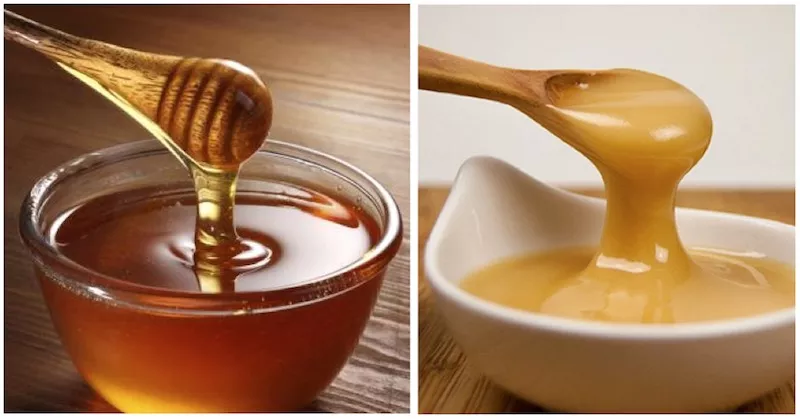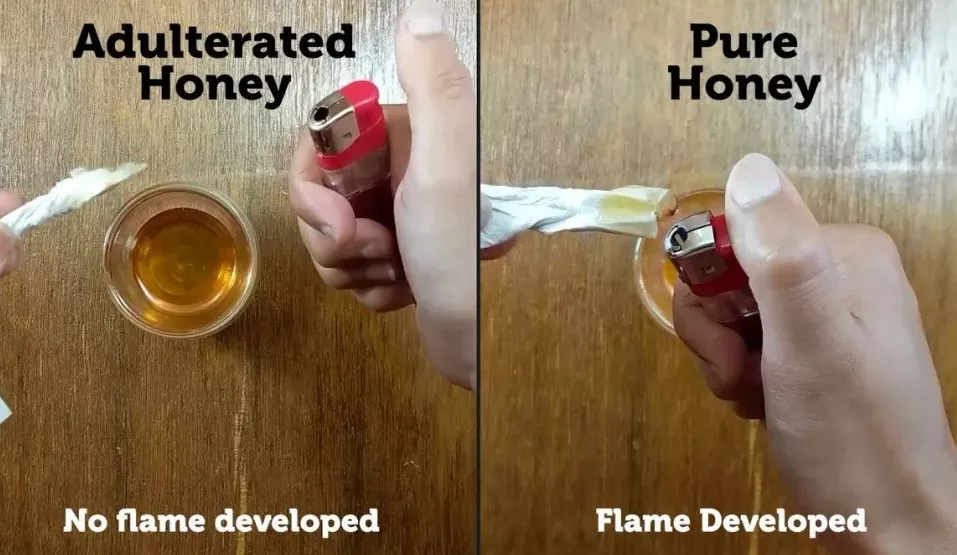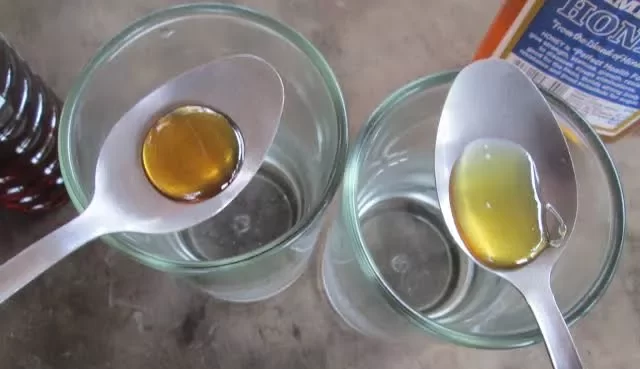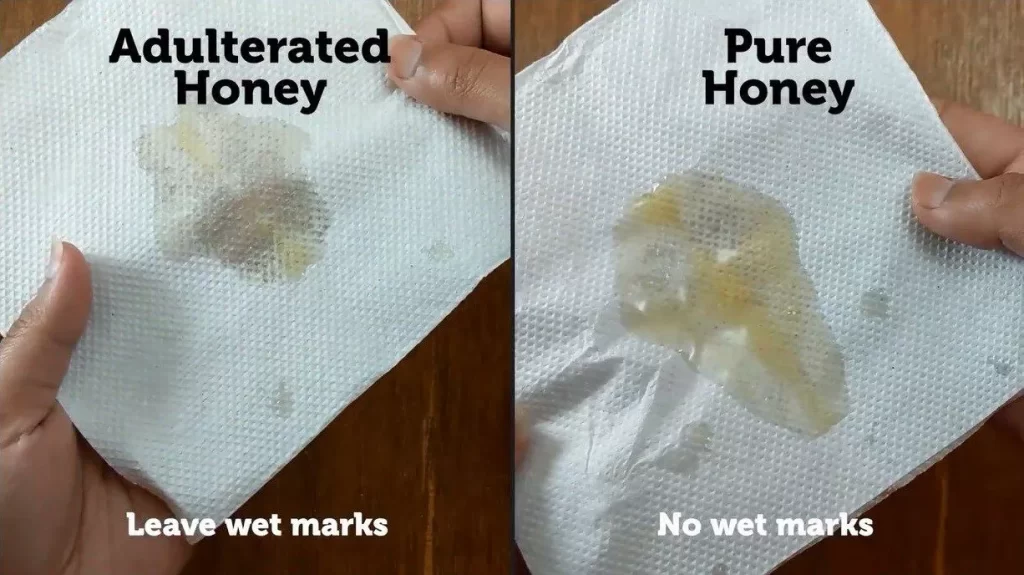Studies have shown that raw honey, which contains a small amount of pollen grains, is good for you. On the other hand, raw honey does not have a long shelf life like regular or filtered honey. So these facts have left many people confused about whether to stick with filtered or unfiltered honey and which of the two is best.
Unfiltered honey is still the healthiest. This is because unfiltered honey has not undergone a filtering process such as heating. Therefore, unfiltered honey is rich in enzymes, vitamins, amino acids and minerals. Unfiltered raw honey directly from the beehive is the most nutritious honey with many health benefits.

While filtered and unfiltered honey has considerable benefits, they also have disadvantages. In this article, I will discuss all of this and more. You will also learn how to test honey and what the different honey labels on the market mean. So, without further ado, let’s get down to business.
What Is The Difference Between Filtered And Unfiltered Honey?
Some honey producers say nothing has been added to their honey and nothing has been removed. And other honey producers can say their honey is pure. This term means that honey can be filtered or unfiltered. At the same time, customers may want honey that comes directly from the beehive, pure honey that has not gone through a filtration process. So what is the main difference between filtered and unfiltered honey? How are they made?
Does Beeswax Clog Pores? Is Beeswax Good For Your Skin?
What Is Filtered Honey?
Filtered honey is a processed honey. Filtered honey is heated and then rapidly cooled. This processing technique is to prevent the honey from granulating. The reason beekeepers filter honey is to remove large items from their honey of it to produce a tasty product.
One of the main reasons manufacturers filter honey is to extend the shelf life of the honey. When honey is filtered, it will appear clear and less viscous, making it more acceptable to the typical consumer at your local supermarket! Nonetheless, they have lower nutritional value because processing techniques reduce the amount of active enzymes, vitamins and essential minerals in honey.
The heating process must be precise, otherwise the yeast cells in the honey will be completely destroyed. After the heating process is complete and the honey has cooled, it is filtered. The honey is filtered to remove impurities and crystallized honey, leaving you with clear honey.
What Is Unfiltered Honey?
On the other hand, unfiltered honey is a type of honey that is harvested directly from the beehive and undergoes minimal processing. Unlike filtered honey, which is heated to 60-65°C, unfiltered honey is never heated above 35°C. Honey is not processed in any way other than sieving to remove impurities before packaging.
Unfiltered honey is one of the most nutritious honeys. They are not heat treated like filtered honey, which changes the chemical composition of the honey. Unfiltered honey contains more beneficial bacteria and enzymes than filtered, processed honey. In addition, the antibiotic properties of unfiltered honey were higher as the honey was closer to its natural state. Therefore, if you apply unfiltered honey to an open wound, some believe it can reduce the risk of infection.
Because honey is high in nutrients, some people use it to reduce sensitivity to allergens. However, if you are prone to hay fever, you may not be able to enjoy the rich aroma of honey. Unfiltered honey retains some of the nectar normally lost in processed honey and therefore has a strong aroma. When considering the taste of honey, note that darker varieties of honey are more pungent.
Different Types Of Honey Sold In The Market
While filtered and unfiltered honey are the two most common types of honey, there are several others. Honey is classified by processing, color and texture. This is a useful guide on how manufacturers define their products.
Clover Honey Vs Regular Honey: What’s The Difference?
#1 Pure Honey
When manufacturers say their honey is pure, they mean there are no impurities in the honey. This means that honey has been processed to remove various forms of impurities. So you get 100% honey without additives like corn syrup. Manufacturers sometimes add corn syrup to industrial production of honey to keep costs down.
Note, however, that pure honey does not always state how the honey was made or the variety on the honey label. Therefore, it is recommended that you look up more information on the labeling of honey as pure honey to ensure that you are getting the full benefits of honey when you receive it.
#2 Raw Honey
Some manufacturers label their honey containers as raw honey. If you see a honey jar with a raw honey label, it means the honey is pure and not heated to the point of pasteurization. Raw honey has several benefits, most notably the naturally occurring vitamins, enzymes, and minerals that are preserved in honey.
Unlike pure honey, raw honey gives you the full benefits of consuming honey. Most beekeepers who produce raw honey know that the way they care for their bees and handle their honey can have a major impact on the honey. So, like honey-producing bees, raw honey needs to be handled with care. If you have to choose between raw honey and pure honey, raw honey is a better choice for taste, health and environment.
#3 Organic Honey
Organic honey is another common type of honey made from the pollen of flowering plants, grown organically and free of chemicals to treat bees. If you choose organic honey, be sure to avoid any pesticides that may be sprayed on or near the plants where the bees collect nectar to produce honey. Note that bees can fly up to 2 miles from the hive to collect flowers.
Therefore, beekeepers wishing to produce organic honey are wary of plants within this 2-mile radius, and must be certified organic for the honey to be truly organic. However, this can be difficult to monitor, but organic certification is a great way to ensure hive owners are sure it’s truly organic. Note that honey labeled as organic does not necessarily mean the honey is minimally processed or unprocessed, unless it is labeled as organic.
#4 Filtered vs Unfiltered Honey
Honey can be filtered through a means that removes very small particles, usually as small as pollen. Note, however, that filtered honey is not the same as sifted honey. Honey is usually sifted to remove bee parts and other large debris before being jarred, while the honey still retains pollen and other beneficial properties.
Therefore, unfiltered honey does not necessarily mean that the honey is raw unless it is labeled as such. Also, unfiltered honey is closer to being directly from the hive than filtered honey. If you choose unfiltered honey, you can be sure to retain most of the honey’s properties.
Light Honey Vs Dark Honey: Differences, Uses, Appearance, Taste
#5 Dark and Light Honey
Another way to differentiate between different types of honey is by color. Honey can be dark or light. Note that dark honey is generally more nutritious than light honey. Also, dark honey has a stronger flavor than light honey. Most dark honeys contain higher concentrations of potent nutrients and antioxidants than light honeys.
Generally speaking, the antioxidants in dark honey fight free radicals, molecules that damage cells. Dark honeys have a distinctly strong flavor, while light honeys are generally milder. Their color, moisture and flavor content vary depending on the nectar source.
#6 Creamed Honey
Creamed honey is a honey that has been processed to control crystallization. Therefore, creamed honey is usually creamier and thicker than regular honey. Also, creamed honey is suitable for spreading on your favorite sandwiches or pastries. Note that creamed honey is usually crystalline, which means that creamed honey contains tiny honey crystals that are blended, not whipped, to create the final delicacy.
It’s important to note that honey with a creamed honey label means the honey may contain a lot of small crystals. These small crystals help prevent larger crystals from forming in raw honey. Processing honey using this method can cause the glucose in the honey to crystallize. Also, because its glucose forms naturally pure white crystals in honey, cream honey is usually lighter in color than the same flower.
#7 Raw Honey
Raw honey and creamed honey are the same thing. The only difference between whipped and creamed honey is that they contain tiny honey crystals that are whipped and mixed to make it spreadable. Whipped honey and whipped butter are similar. Note: Raw honey is great for cookies, toast, and rolls.
Whipped honey is a process of making honey with controlled crystallization. However, since honey contains many small crystals, whipped honey prevents the formation of large crystals. Choosing to buy raw honey is not only good for your health, but it also gives you the ultimate taste.
#8 Crystallized Honey
Finally, I want to talk about crystallized honey. Generally speaking, as a natural product, honey will eventually solidify or crystallize. In liquid honey, crystallization occurs when the suspended sugars form a natural bond with each other. Crystallized honey is edible, safe and pleasing. You can liquefy crystallized honey if you wish. Liquefying crystallized honey is as simple as placing a honey jar in warm water and heating it gently until the crystals dissolve.
If the honey is packaged in a plastic bottle, do not heat the honey in the bottle. Microwaving honey in a plastic bottle will melt the bottle, making the honey inedible. Also, handling hot plastic accidentally can leave you with severe burns.
Which Honey Is The Healthiest?
When choosing the healthiest type of honey, it’s always best to look for honey that is labeled raw. This is because all the health benefits of honey are associated with raw honey. Raw honey is minimally processed by beekeepers, making it a healthier honey.
Raw honey is not pasteurized and does not go through a rigorous filtration process that reduces its nutritional content. Because raw honey undergoes minimal processing, it contains all of the important minerals, enzymes, vitamins and amino acids intact.
Also, it can be difficult to know what is unhealthy or healthy without testing first. Later in this article, I’ll share with you some ways to test honey. These tests will help you differentiate between real honey and adulterated honey.
What Happens When You Add Honey To Hot Tea? Does Honey Lose Nutrients?
What Are The Benefits Of Raw Or Unfiltered Honey?
Raw honey has been an important ingredient in many remedies because of its many benefits throughout history. Some hospitals even use it to treat wounds. Most of these health benefits are specific to unpasteurized or raw honey. If you’re interested in trying out the potency of raw honey, be sure to buy it from a trusted local producer. Here are some health benefits of using raw or unfiltered honey.
#1 A Good Source of Antioxidants
Bees collect nectar from many plants that contain chemicals that act as antioxidants. So when these nectars are stored as honey by bees, they contain many antioxidants that rival vegetables and fruits. Antioxidants help protect the body from cell damage caused by free radicals.
Free radicals are responsible for the aging process. Free radicals also contribute to the development of various chronic diseases, such as heart disease and cancer. Research over the years has shown that honey contains antioxidant compounds called polyphenols. Polyphenols play an important role in preventing heart disease.
#2 Antifungal And Antibacterial Properties
Research has also shown that raw honey has antifungal and antibacterial properties. Therefore, honey can kill fungi and bacteria. So if you or someone you know has a fungal or bacterial infection, raw honey is a great remedy.
Honey naturally contains hydrogen peroxide, which is a preservative. The effectiveness of honey as an antifungal or antibacterial agent varies from honey to honey. You might be surprised at how effective natural honey can be as a remedy for these types of infections.
#3 Healing Wounds
Are you hurt? Medicinal Manuka honey can be used to treat wounds because of its antiseptic properties. Manuka honey is used in medical settings to treat wounds because it is an effective antiseptic. In addition, honey also aids in tissue regeneration.
Research has also shown that Manuka honey can reduce infections and speed up healing time. Note, however, that the honey used in hospitals is medicinal honey, which means it is tested and sterile. Treating wounds and cuts with store-bought honey is not recommended.
Does Honey Freeze? What Happens When You Freeze Honey?
#4 Boost Immunity
Raw honey is also rich in phytonutrients that boost our immune system. Phytonutrients are compounds found in abundance in plants that help protect them from damage. For example, phytonutrients keep insects away and protect plants from disease.
The phytonutrients in honey are responsible for its antioxidant properties. Phytonutrients also contribute to the antifungal and antibacterial properties of honey. Phytonutrients are one of the reasons honey has cancer-fighting and immune-boosting properties. Heavy processing of honey, such as pasteurization, can destroy these valuable nutrients.
#5 Helps Digestive Problems
Another benefit of raw honey is that it can be used to treat digestive problems. Although there is not much research to prove it is very effective. Nonetheless, our research shows that honey is effective in treating a common bacteria in the digestive tract, Helicobacter pylori. Note that Helicobacter pylori is the leading cause of stomach ulcers.
Raw honey is also a very powerful prebiotic. This means raw honey can feed the good bacteria in your gut. As such, these bacteria support an individual’s digestion and overall health.
#6 Relieves Sore Throat
If you have a cough or a sore throat, raw honey can help relieve this feeling. For a more effective remedy, add honey to hot lemon tea for sore throats and coughs.
Studies have shown that honey contains a mixture of compounds that are as effective as dextromethorphan. Dextromethorphan is a common ingredient used in making over-the-counter cough suppressants.
What Are The Disadvantages Of Eating Raw Honey?
Considering that raw honey is the product of bees, one might wonder if it is safe enough to be eaten without processing. Although honey is a safe and healthy product on its own, it can contain impurities.
While some of these contaminants may be responsible for honey’s prebiotic properties, raw honey may also contain harmful bacteria, such as botulinum. Spores of bacterial Clostridium are especially dangerous to babies. Therefore, never give raw honey to babies under the age of one without a doctor’s prescription. Symptoms of botulism include:
- Lethargy
- Poor feeding
- Paralysis
- Loss of head control
- Sagging eyes
- Slow breathing
- Constipation
What are the benefits of regular or filtered honey?
To address the disadvantages of eating raw honey, beekeepers have decided to process raw honey as well, resulting in filtered honey. While regular honey may not be as nutritious as raw honey, it does have quite a few benefits. Here are some of the benefits of regular or filtered honey.
#1 Longer Shelf Life
There is a saying that honey never goes bad. Although this is largely true. But after a few years, the taste of honey changed. This variation is common in raw honey. But when honey is processed, shelf life increases significantly and you won’t notice any change in taste.
To make filtered honey, manufacturers extract honey from the honeycombs of a beehive. The honey is then poured into a sieve or nylon cloth to remove any impurities. After this, the honey is then pasteurized to destroy the yeast in the honey, which also makes the honey smoother and also increases its shelf life.
How Much Does A Bee Weigh And Size of the Bee?
#2 More Delicious
Another advantage of filtered honey compared to raw honey is that it is tastier. This is because impurities in the honey are removed when raw honey is processed. Also, filtered honey is more aesthetically pleasing. People who may not like honey due to this strong aroma will find filtered honey tastier because the processing reduces the amount of pollen in the honey. Therefore, filtered honey does not have the strong aroma of raw honey.
In some cases, commercial honey is ultrafiltered. Ultrafiltration further refines the honey, making it smoother and more transparent. Note, however, that ultrafiltration can also remove beneficial nutrients such as enzymes, antioxidants, and pollen.
What Are The Disadvantages Of Taking Regular Honey?
Pure or filtered honey is not as beneficial as raw honey. This is because regular honey is heavily processed, making it less nutritious than raw honey. Most of the health benefits associated with honey consumption are destroyed during the processing of regular honey.
Unfiltered honey contains a large amount of pollen, while regular honey has been sifted and filtered, it contains almost no pollen.
To compensate for the chemical loss of regular or filtered honey, manufacturers often add additives such as corn syrup. While the addition of corn syrup must be listed as an added ingredient, not all manufacturers adhere to this standard. High fructose corn syrup looks like honey. So if it’s about the same moisture content as honey, add them to honey and you won’t be able to tell the difference.
How Can You Spot Fake Honey?
When it comes to distinguishing between fake and raw honey, it all depends on the type of testing you do. Knowing which tests are myths and which are real becomes critical! However, please note that testing honey is not 100% accurate. Here are three tests you can use to differentiate fake honey from real honey.
#1 Flame Test
One way to test whether honey is real is its flammability. The flame test is a common test used by many people to this day. If you do the flame test, repeat it a few times to see if the honey always gives the same result. This test checks whether water has been added to the honey.
To do the flame test, place a lit match or lighter near the honey. Honey itself is a flammable substance. So if you bring the fire close to the honey, it should ignite. If the honey burns, it means the honey is real. But on the other hand, if the honey doesn’t burn, it means the honey is adulterated.

#2 Hot Water Test
Another test you can use to determine if honey is fake is its solubility. To do the warm water test, take a teaspoon of honey and pour it into a glass or cup of warm water. If the honey is real, it will settle in a lump at the bottom of the jar due to its dense texture.
On the other hand, if the honey dissolves in the water, that means the honey is neither real nor fake. Note that adulterated honey or pure honey is also sold in creamy (uniformly crystallized) or solid honeycomb form. This honey is very difficult to dissolve, whether the honey is pure or adulterated.

#3 Drop Honey On Paper Towel To Test
Another way to tell if honey is adulterated or diluted with water is with paper towels. Put a few drops of honey on a paper towel. If the honey is mixed with water, the paper towel will become wet, indicating the presence of water, as the paper towel will absorb water.
But if the honey isn’t adulterated, the tissue won’t get wet. The only downside to this test is that the paper test won’t be as effective if the honey is mostly diluted with syrup. This is because syrup does not leave wet streaks on paper towels like honey does with water.

Can You Eat Honeycomb? Benefits, Uses, And Dangers
In Conclusion
Ultimately, raw honey is different from regular honey because it’s processed differently. If you have to choose between filtered and unfiltered honey, choose unfiltered honey. This is because all the health benefits of consuming honey are associated with unfiltered honey. The main difference is that raw honey is only sifted before bottling, thus retaining all the beneficial nutrients. Regular honey, on the other hand, undergoes heavy processing such as pasteurization before bottling, causing it to lose most of its beneficial nutrients.

